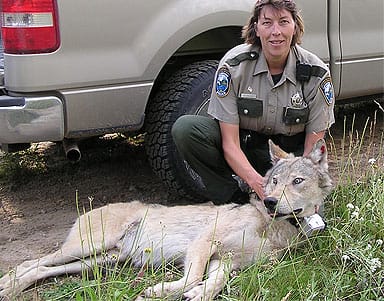Washington’s Second Wolf Pack Confirmed
Wolf activity being monitored in Pend Oreille County Wa.


Oreille County Wa – -(AmmoLand.com)- Washington’s second gray wolf pack has been confirmed and an adult wolf has been equipped with a satellite-telemetry tracking collar by state biologists in northeast Washington’s Pend Oreille County.
This morning, biologists with Washington Department of Fish and Wildlife (WDFW) led by a wolf expert from the Idaho Department of Fish and Game temporarily captured a 105-pound wolf-believed to be the alpha-male pack leader-to equip it with a satellite-telemetry collar so its movements can be tracked. Two wolf pups also were temporarily captured, equipped with ear tags and released.
The collared wolf’s movements will be monitored with periodic relocation data transmitted by satellite and downloaded on a computer. The Global Positioning System (GPS) equipment allows monitoring without the aerial or ground tracking required in standard radio telemetry.
Biologists found earlier evidence of the wolf pack-they have named the Diamond Pack-through howling responses from multiple wolves of various ages, and from photos of up to four young wolves recorded on a remote, motion-triggered camera. A wolf pack is defined as two or more wolves traveling together.
Biologists with WDFW and the Washington Department of Natural Resources (DNR) have been monitoring the area in recent weeks, after a DNR remote camera recorded images in May of what appeared to be an adult male and female gray wolf. The female wolf was lactating, indicating she was nursing pups. Subsequent genetic testing of a hair sample collected from a camera station indicated the hair came from a male gray wolf from the northwestern Montana/southwestern Alberta wolf population.
More recently biologists conducted howling surveys, and responding howls were heard from multiple wolves-both juvenile and adult.
Last summer, Washington’s first breeding pair of wolves found since the 1930s was radio-collared in western Okanogan County in north-central Washington.
Gray wolves were removed from Washington by the 1930s as a result of trapping, shooting and poisoning, and later listed as both a federal and state endangered species.
Gray wolf populations in nearby Idaho, Montana and Wyoming have rebounded in recent years as a result of federal recovery efforts in the northern Rocky Mountains. Gray wolves were recently removed from the federal endangered species list in those areas and the eastern third of Washington, including Pend Oreille County. They remain federally listed as endangered in the western two-thirds of Washington and state endangered throughout Washington.
WDFW is in the process of drafting a gray wolf conservation and management plan, which will be circulated for public comment later this year, and will be considered for adoption by the Washington Fish and Wildlife Commission in 2010. The draft plan was developed with a 17-member citizen working group composed of wolf conservation representatives, ranchers and hunters.
Anyone wishing to report a possible wolf sighting or activity should call a toll-free wolf reporting hotline at 1-888-584-9038. Those with concerns about possible wolf-caused livestock depredation should contact the USDA Wildlife Services office in Olympia at (360) 753-9884 or the U.S. Fish and Wildlife Service office in Wenatchee at (509) 665-3508.
